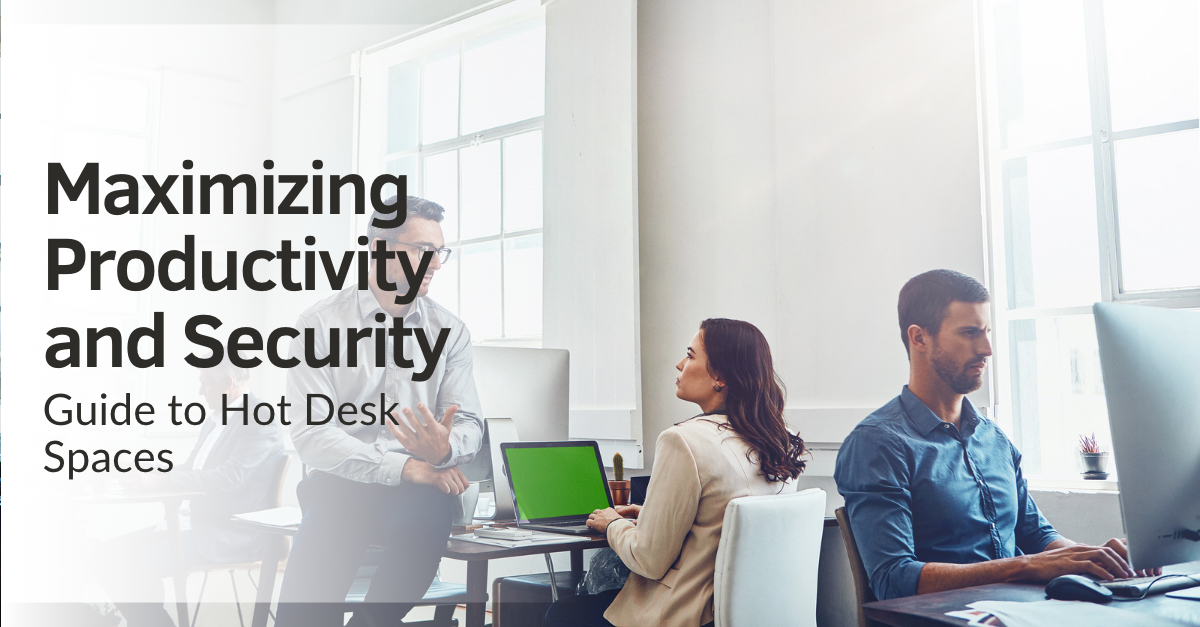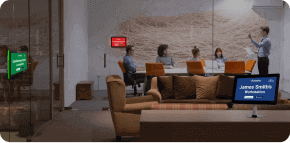Blog

Maximizing Productivity and Security: Guide to Hot Desk Spaces
Hot desking has gained traction recently, providing a flexible and cost-effective solution for businesses looking to optimize their office space. As the modern workforce becomes more mobile, companies are embracing the benefits of hot desking while navigating its challenges.
In this article, we’ll explore the ins and outs of hot desk office spaces, discuss office space requirements for successful implementation, and delve into the importance of office security and desk booking systems in a hot desk environment.
Office Space Requirements for Hot Desking
Before transitioning to a hot desk office space, it’s essential to assess your company’s specific needs and consider various factors when designing the new layout.
Key considerations include:
1. Number of employees:
- Determine the maximum number of employees who will use the hot desk space at any given time.
- Plan for growth and ensure there’s enough capacity for potential future expansion.
2. Work patterns:
- Analyze employees’ schedules and work patterns (full-time, part-time, remote workers).
- Consider peak hours and days to ensure enough desks and workstations are available.
3. Type of work being performed:
- Identify the types of tasks employees will perform in the hot desk environment (individual tasks, team collaborations, client meetings).
- Design the space to accommodate various work styles and activities.
4. Amenities and technology resources:
- Provide high-speed internet and reliable Wi-Fi coverage throughout the workspace.
- Equip workstations with necessary hardware and software (computers, monitors, phones).
- Offer collaboration tools (whiteboards, screens for presentations, video conferencing equipment).
- Ensure comfortable seating, ergonomic furniture, and adequate lighting.
5. Striking a balance between flexibility and access to resources:
- Create designated quiet areas for focused work and phone calls.
- Establish collaboration zones for team meetings, brainstorming sessions, and informal discussions.
- Designate spaces for impromptu meetings and breaks, such as a lounge area or a coffee corner.
- Offer easily accessible storage solutions for employees to store their belongings and work materials.
By carefully considering these factors and designing a well-planned hot desk office space, businesses can successfully create an environment that meets the needs of their employees while maximizing productivity and flexibility.
The Importance of Office Space Desk Booking
Implementing a desk booking system is crucial for the efficient functioning of office space desk booking. A well-designed booking system can provide numerous benefits:
- Prevent conflicts over desk usage
- Ensure employees have access to the resources they need
- Provide valuable insights into office space utilization
When selecting a desk booking software, consider the following features:
1. Ease of Use
Choose software with a user-friendly interface for easy navigation and booking. Look for options that offer a mobile app or web-based access for on-the-go reservations.
2. Compatibility with Existing Systems
Choose a booking software that integrates with calendar systems (e.g., Outlook, Google Calendar) for seamless scheduling in the workplace. Additionally, ensure that the software is compatible with other office tools and applications to promote smooth operations and collaboration.
3. Reporting and Analytics Capabilities
Choose software that can generate usage reports to monitor desk occupancy and space utilization. Opt for a solution that can identify trends and patterns to inform future workspace planning.
To ensure a successful desk booking system implementation:
1. Communicate with your employees.
- Clearly explain the benefits of the desk booking system.
- Address any concerns or questions employees may have.
2. Provide proper training for your workforce.
- Offer training sessions or workshops to familiarize employees with the booking software.
- Provide written or video tutorials for reference.
3. Monitor and address issues in the workplace.
- Regularly review usage data and gather feedback from employees.
- Address any issues or concerns promptly to maintain a smooth booking process.
By considering these factors and implementing a robust desk booking system, businesses can enhance the overall efficiency and productivity of their hot desk office spaces.
Ensuring Office Security in a Hot Desk Environment
In a hot desk office space, ensuring the security of sensitive information and assets is paramount. As employees share workstations, there’s an increased risk of unauthorized access to confidential data, theft of physical devices, and potential breaches in cybersecurity. To mitigate these risks, businesses should take the following steps:
Step #1: Implement Secure Access Controls
- Install access control systems (e.g., keycards, biometrics) to restrict entry to authorized personnel.
- Limit access to sensitive areas or resources within the workspace.
Step #2: Protect Digital Assets
- Enforce strong password policies and require regular password updates.
- Utilize multi-factor authentication (MFA) for added security.
- Implement encryption for data storage and transmission.
- Keep software and systems up-to-date with the latest security patches.
Step #3: Secure Physical Devices
- Provide lockable storage for employees to secure their belongings, including laptops and other devices.
- Install security cameras and alarms in strategic locations.
- Implement a clear desk policy to minimize the risk of information theft.
Step #4: Educate Employees About Security Best Practices
- Regularly hold security awareness training sessions to educate employees on potential threats and best practices.
- Emphasize the importance of securing personal belongings and not leaving sensitive information unattended.
- Encourage employees to log out of systems when not in use and lock their workstations when stepping away.
- Foster a culture of vigilance and urge employees to report any suspicious activities or security incidents.
Step #5: Develop and Enforce Security Policies
- Establish clear and comprehensive security policies tailored to the hot desk environment.
- Communicate policies to employees and provide guidelines for compliance.
- Periodically review and update policies to address emerging threats and vulnerabilities.
Step #6: Monitor and Respond to Security Incidents
- Implement a centralized system for monitoring and reporting security incidents.
- Regularly review security logs and reports to identify potential issues.
- Develop an incident response plan to address security breaches swiftly and effectively.
By taking these proactive steps, businesses can ensure the security of their hot desk environments and protect sensitive information and assets while maintaining a productive and flexible workspace.
Tips for a Successful Hot Desk Space
Creating a successful hot desk space involves more than just providing desks and workstations; it requires fostering a positive culture, maintaining a balance between flexibility and structure, and ensuring a clean and organized environment. Here are some essential tips to help businesses achieve success in their hot desk spaces:
. Encourage a Positive Hot Desking Culture
a. Foster a sense of community:
- Host regular team-building activities and events that bring employees together.
- Create a welcoming and inclusive atmosphere that encourages interaction and collaboration.
b. Encourage open communication:
- Facilitate open dialogue between employees and management.
- Implement communication tools (e.g., messaging platforms, intranet) to keep employees informed and connected.
c. Recognize and celebrate achievements:
- Highlight individual and team accomplishments.
- Use recognition programs and rewards to motivate and engage employees.
2. Balance Flexibility and Structure
a. Designate areas for specific tasks:
- Create zones for focused work, collaboration, and relaxation.
- Clearly label and communicate the purpose of each area to employees.
b. Provide access to necessary resources:
- Ensure employees have access to the technology, tools, and equipment they need for their tasks.
- Maintain a well-stocked supply of office essentials (e.g., stationery, printer supplies).
c. Implement a desk booking system:
- Streamline desk allocation to ensure employees have access to a workspace when needed.
- Make the booking process user-friendly and efficient.
3. Keep the Workspace Clean and Organized
a. Establish cleanliness guidelines:
- Communicate expectations for maintaining a clean and clutter-free environment.
- Encourage employees to clean up after themselves and be considerate of others.
b. Provide cleaning supplies:
- Make cleaning supplies readily available (e.g., disinfectant wipes, hand sanitizer).
- Regularly restock supplies and ensure employees know where to find them.
c. Implement a clean desk policy:
- Encourage employees to clear their workstations at the end of each day.
- Provide storage solutions for personal belongings and work materials.
d. Schedule regular cleaning services:
- Hire professional cleaning services to maintain the overall cleanliness of the office space.
- Address specific cleaning needs, such as deep cleaning of shared equipment and high-touch surfaces.
4. Facilitate Collaboration and Productivity
a. Provide tools and technology for collaboration:
- Equip the office with collaboration tools, such as whiteboards and video conferencing equipment.
- Ensure reliable internet connectivity for seamless communication.
b. Optimize the office layout:
- Arrange workstations and furniture to facilitate teamwork while reducing noise and distractions.
- Consider acoustic solutions, such as sound-absorbing panels or partitions, to improve the work environment.
5. Gather Feedback and Adapt
a. Solicit employee input:
- Regularly gather feedback from employees on their hot desk experiences.
- Use employee insights to identify areas for improvement and address concerns.
b. Monitor and adjust:
- Regularly evaluate the effectiveness of the hot desk space and make necessary adjustments.
- Remain flexible and open to change, adapting the workspace to meet the evolving needs of the workforce.
By following these tips, businesses can create a successful hot desk space that fosters productivity, collaboration, and employee satisfaction in a flexible and efficient work environment.
Bottom Line
In summary, hot desking can be a highly effective office arrangement for many businesses looking to maximize productivity, reduce overhead costs, and adapt to the evolving needs of their workforce. By understanding the advantages and challenges of hot desking, companies can make informed decisions on whether this approach is suitable for their specific needs.
By following the tips and strategies outlined in this comprehensive guide, businesses can confidently embrace hot desking as a viable and beneficial office space solution, ultimately maximizing productivity and security in the modern workplace.















































 Support
Support  Demo
Demo  Blog
Blog